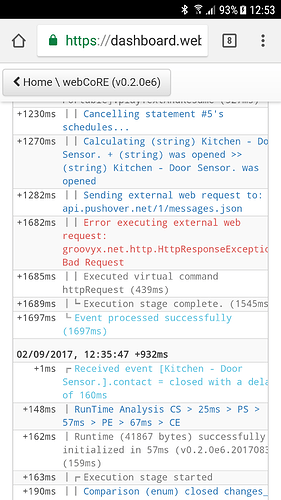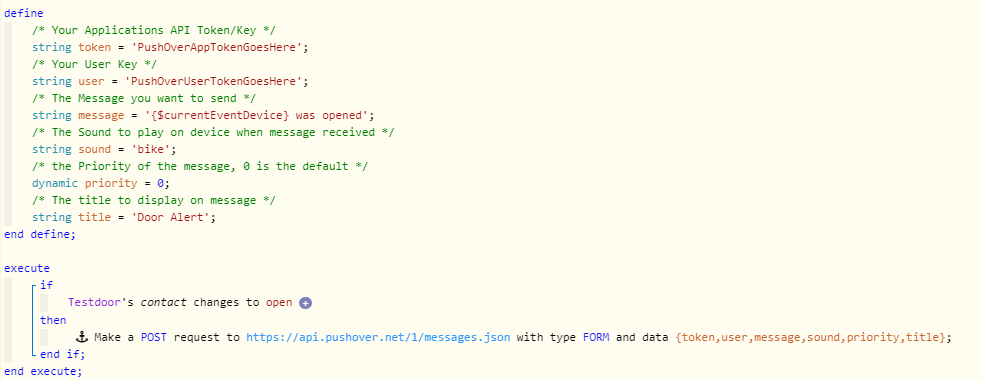Used email address as user.
Used the token in the app but I’m getting the following error.
Send Pushover notifications
You need to add a new application in pushover then use the that as the token and your user key as user, email address is not used anywhere.
the “Your User Key” is on the main page of https://pushover.net/ when you log in
the app key “API Token/Key” is on the application you create “Your Applications (Create an Application/API Token)” on same page
you will also need to install the pushover app on your phone if not already (for that you use the login information, not tokens) 
when I created the app in pushover website, I used this for icon, call the app something like MySmartThingsApp, creating different apps for different uses allows you to use different icons based on what is sending the push, for example my uptimerobot alerts use their icon, helps to visually see where from

is confusing sense
token = app token
user = user token
@John68 you have posted very helpful information on this thread about how to use pushover with webcore. it would be great if you took the relevant parts from those posts and made one post in the examples categories on how to use pushover. users might find it easier to follow and find with search.
thank you.
“Should it do anything else apart from say which door has been opened?”
I should of added, in the sample, I sent a msg to my sonos speakers and a pushover alert
could remove the sonos speakers part if just testing the pushover stuff
I moved this into feature suggestions category. But,@John68 and/or @ipaterson if you’re willing to do a single write up and/or video tutorial, this would be a big community asset, and that would have a great home in the tutorials category!
I am just learning myself, ipaterson was the one that came up with the way to make it happen
I’m going to start by working on an example of the Smart notify piston using Pushover, but there would be value in some generic advice as well, thanks for the suggestion.
Is there a way to have multiple messages for different if/then statements to choose from within 1 piston? (newbie here)
Did you ever figure this out? I want to accomplish the same thing but am having trouble…
I’ve used this very often - it’s great. However, due to the changes in Smartthings, I’m moving to Hubitat. So I tried to copy this to WebCore, but can’t seem to get i working. Should anything be different for doing this with WebCore in Hubitat?
In Hubitat, there is a native pushover driver.
You have to create a device for it
HE console -> devices -> + Add Device -> Virtual -> scroll down to Pushover driver
then configure it with your keys, etc.
Now you can use it in various apps, etc.
Thanks for your reply.
Yes, I know. But I just really like this solution and was confused about why it wouldn’t work. It ought to just by adding a new token? But does not.
I want to send to two or three different users, so I can separate the notifications.
There is another community written driver you can consider:
You can ask a question in the HE forum more specifically to what you want the device handler to be able to do.
Otherwise post your piston (or a private message if you think webcore is mis-behaving, and I can take a look for HE).
What option would we select to use the native driver device for PUSHOVER to send notifications in the same format as RM uses?
Currently using the Make Post request. Would love to just use enhanced driver’s for it’s ease.
you should be able to select the pushover driver then select commands it offers…
If you are having an issue show your piston, but if you enable the device with webcore, it should be able to be selected within your piston


